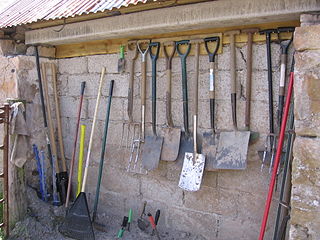 W
WA garden tool is any one of many tools made for gardening and overlaps with the range of tools made for agriculture and horticulture. Garden tools can be divided into hand tools and power tools.
 W
WThe ard, ard plough, or scratch plough is a simple light plough without a mouldboard. It is symmetrical on either side of its line of draft and is fitted with a symmetrical share that traces a shallow furrow but does not invert the soil. It began to be replaced in China by the heavy carruca turnplough in the 1st century, and in most of Europe from the 7th century.
 W
WAn averruncator is a form of long shears used in arboriculture for averruncating or pruning off the higher branches of trees, etc.
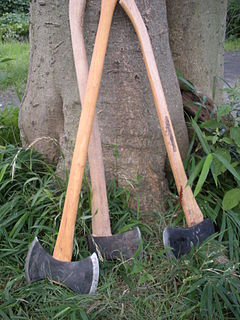 W
WAn axe is an implement that has been used for millennia to shape, split and cut wood, to harvest timber, as a weapon, and as a ceremonial or heraldic symbol. The axe has many forms and specialised uses but generally consists of an axe head with a handle, or helve.
 W
WA berry-picking rake or berry picker is a tool for collecting berries. Berry-picking rakes can be used to collect lingonberries, bilberries, currants, and other berries. The rake may damage softer berries, and introduces some detritus, requiring cleaning of the berries afterwards. If misused, it may also damage or uproot the plants, reducing next year's yields. Despite these drawbacks, a rake has much greater efficiency than picking by hand and is thus used in all commercial berry picking - though modern large-scale farms use mechanical harvesters.
 W
WA billhook or bill hook is a versatile cutting tool used widely in agriculture and forestry for cutting woody material such as shrubs, small trees and branches and is distinct from the sickle. It was commonly used in Europe with an important variety of traditional local patterns. Elsewhere, it was also developed locally such as in the Indian subcontinent, or introduced regionally as in the Americas, South Africa and Oceania by European settlers.
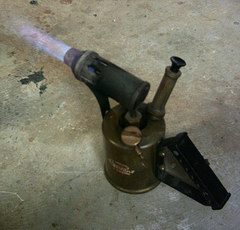 W
WA blowtorch is a fuel-burning tool used for applying flame and heat to various applications, usually metalworking.
 W
WIn farming and gardening, the broadfork, also called a U-fork or grelinette, is a tool used to manually break up densely packed soil, including hardpan, to improve aeration and drainage. Broadforks are used as part of a no-till or reduced-till seedbed preparation process because they preserve the soil structure and avoid the resurfacing of weed seeds.
 W
WA brushcutter is a powered garden or agricultural tool used to trim weeds, small trees, and other foliage not accessible by a lawn mower or rotary mower. Various blades or trimmer heads can be attached to the machine for specific applications.
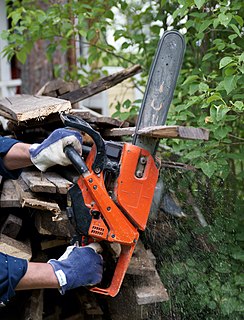 W
WA chainsaw is a portable gasoline-, electric-, or battery-powered saw that cuts with a set of teeth attached to a rotating chain driven along a guide bar. It is used in activities such as tree felling, limbing, bucking, pruning, cutting firebreaks in wildland fire suppression, and harvesting of firewood. Chainsaws with specially designed bar-and-chain combinations have been developed as tools for use in chainsaw art and chainsaw mills. Specialized chainsaws are used for cutting concrete during construction developments. Chainsaws are sometimes used for cutting ice, for example, ice sculpture and winter swimming in Finland.
 W
WA cultivator is any of several types of farm implement used for secondary tillage. One sense of the name refers to frames with teeth that pierce the soil as they are dragged through it linearly. Another sense refers to machines that use rotary motion of disks or teeth to accomplish a similar result. The rotary tiller is a principal example.
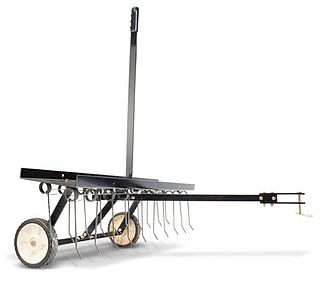 W
WA dethatcher or lawn scarifier is a device that removes thatch from lawns. Types of dethatchers include motorized dethatchers or those that can be pulled behind a garden tractor.
 W
WA dibber or dibble or dibbler is a pointed wooden stick for making holes in the ground so that seeds, seedlings or small bulbs can be planted. Dibbers come in a variety of designs including the straight dibber, T-handled dibber, trowel dibber, and L-shaped dibber.
 W
WIn archaeology and anthropology, a digging stick, or sometimes yam stick, is a wooden implement used primarily by subsistence-based cultures to dig out underground food such as roots and tubers or burrowing animals and anthills. The stick may also have other uses in hunting or general domestic tasks.
 W
WAn earth auger, earth drill, or post-hole auger is a drilling tool or machine used for making holes in the ground. It typically consists of a rotating vertical metal rod or pipe with one or more blades attached at the lower end, that cut or scrape the soil.
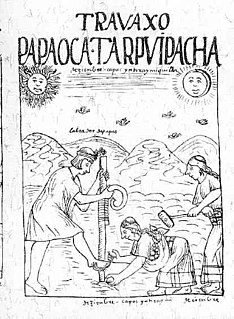 W
WThe foot plough is a type of plough used like a spade with the foot in order to cultivate the ground.
 W
WA garden fork, spading fork, digging fork or graip is a gardening implement, with a handle and several short, sturdy tines. It is used for loosening, lifting and turning over soil in gardening and farming. It is used similarly to a spade, but in many circumstances it is more appropriate than a spade: the tines allow the implement to be pushed more easily into the ground, it can rake out stones and weeds and break up clods, it is not so easily stopped by stones, and it does not cut through weed roots or root-crops. Garden forks were originally made of wood, but the majority are now made of carbon steel or stainless steel.
 W
WA garden hose, hosepipe, or simply hose is a flexible tube used to convey water. There are a number of common attachments available for the end of the hose, such as sprayers and sprinklers. Hoses are usually attached to a hose spigot or tap.
 W
WA grain cradle or cradle, is a modification to a standard scythe to keep the cut grain stems aligned. The cradle scythe has an additional arrangement of fingers attached to the snaith to catch the cut grain so that it can be cleanly laid down in a row with the grain heads aligned for collection and efficient threshing.
 W
WA Grass Stitcher is a gardening tool primarily used to repair and aerate lawns. Common uses include weed control by agitating the surface of the soil, loosening the soil, and preparing it prior to spreading grass seed. As a tool it is hand held and designed to be used while standing and have the spiked wheels pushed back and forth over the earth to be treated.
 W
WA hedge trimmer, shrub trimmer, or bush trimmer is a gardening tool or machine used for trimming hedges or solitary shrubs (bushes). Different designs as well as manual and powered versions of hedge trimmers exist.
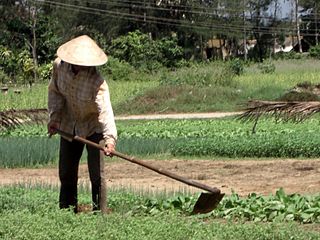 W
WA hoe is an ancient and versatile agricultural and horticultural hand tool used to shape soil, remove weeds, clear soil, and harvest root crops. Shaping the soil includes piling soil around the base of plants (hilling), digging narrow furrows (drills) and shallow trenches for planting seeds or bulbs. Weeding with a hoe includes agitating the surface of the soil or cutting foliage from roots, and clearing soil of old roots and crop residues. Hoes for digging and moving soil are used to harvest root crops such as potatoes.
 W
WAn irrigation sprinkler is a device used to irrigate agricultural crops, lawns, landscapes, golf courses, and other areas. They are also used for cooling and for the control of airborne dust. Sprinkler irrigation is the method of applying water in a controlled manner in way similar to rainfall. The water is distributed through a network that may consist of pumps, valves, pipes, and sprinklers.
 W
WA kunai is a Japanese tool thought to be originally derived from the masonry trowel. The two widely recognized variations of the kunai are short kunai and the big kunai. Although a basic tool, in the hands of a martial arts expert, the kunai could be used as a multi-functional weapon. The kunai is commonly associated with the ninja, who used it to gouge holes in walls. Many popular manga characters use kunai as both their primary and secondary weapons.
 W
WA lawn aerator is a garden tool designed to create holes in the soil in order to help lawn grasses grow. In compacted lawns, aeration improves soil drainage and encourages worms, microfauna and microflora which require oxygen.
 W
WA lawn mower is a machine utilizing one or more revolving blades to cut a grass surface to an even height. The height of the cut grass may be fixed by the design of the mower, but generally is adjustable by the operator, typically by a single master lever, or by a lever or nut and bolt on each of the machine's wheels. The blades may be powered by manual force, with wheels mechanically connected to the cutting blades so that when the mower is pushed forward, the blades spin, or the machine may have a battery-powered or plug-in electric motor. The most common self-contained power source for lawn mowers is a small internal combustion engine. Smaller mowers often lack any form of propulsion, requiring human power to move over a surface; "walk-behind" mowers are self-propelled, requiring a human only to walk behind and guide them. Larger lawn mowers are usually either self-propelled "walk-behind" types, or more often, are "ride-on" mowers, equipped so the operator can ride on the mower and control it. A robotic lawn mower is designed to operate either entirely on its own, or less commonly by an operator by remote control.
 W
WA lawn sweeper, also known as a leaf sweeper, is a garden tool for the mechanical removal of debris, such as fallen leaves, pine needles, twigs, grass clippings or litter, from a lawn or paved area. Lawn sweepers operate via a rotating brush mechanism that sweeps up the debris and deposits it in a collection hopper for disposal.
 W
WA leaf blower, commonly known as a blower, is a gardening tool that propels air out of a nozzle to move debris such as leaves and grass cuttings. Leaf blowers are powered by electric or gasoline motors. Gasoline models have traditionally been two-stroke engines, but four-stroke engines were recently introduced to partially address air pollution concerns. Leaf blowers are typically self-contained handheld units, or backpack mounted units with a handheld wand. The latter is more ergonomic for prolonged use. Larger units may rest on wheels and even use a motor for propulsion. These are sometimes called "walk behind leaf blowers" because they must be pushed by hand to be operated.
 W
WLoppers are a type of scissors used for pruning twigs and small branches, like pruning shears with very long handles. They are the largest type of manual garden cutting tool.
 W
WA mattock is a hand tool used for digging, prying, and chopping. Similar to the pickaxe, it has a long handle and a stout head which combines either a vertical axe blade with a horizontal adze, or a pick and an adze. A cutter mattock is similar to a Pulaski. It is also commonly known in North America as a "grub axe".
 W
WA pickaxe, pick-axe, or pick is a generally T-shaped hand tool used for prying. Its head is typically metal, attached perpendicularly to a longer handle, traditionally made of wood, occasionally metal, and increasingly fiberglass.
 W
WA pitchfork is an agricultural tool with a long handle and two to five tines used to lift and pitch or throw loose material, such as hay, straw or leaves.
 W
WA post pounder, post driver, post rammer, post knocker or fence driver is a tool used for driving fence posts and similar items into land surfaces. It consists of a heavy steel pipe which is closed at one end and has handles welded onto the sides. It is normally used by one person, but larger versions may require two.
 W
WA Potting bench or gardening table is a kind of workbench used for small gardening tasks such as transplanting seedlings. A basic potting bench has a work surface at bench height, comfortable for a standing person; and storage for potting soil, pots, and tools. The same furniture is often also used to display potted plants, even indoors.
 W
WPruning shears, also called hand pruners, or secateurs, are a type of scissors for use on plants. They are strong enough to prune hard branches of trees and shrubs, sometimes up to two centimetres thick. They are used in gardening, arboriculture, plant nursery works, farming, flower arranging, and nature conservation, where fine-scale habitat management is required.
 W
WA rake is a broom for outside use; a horticultural implement consisting of a toothed bar fixed transversely to a handle, or tines fixed to a handle, and used to collect leaves, hay, grass, etc., and in gardening, for loosening the soil, light weeding and levelling, removing dead grass from lawns, and generally for purposes performed in agriculture by the harrow.
 W
WRhubarb forcers are bell shaped pots with a lid covered opening at the top. Used to cover rhubarb to limit photosynthesis, they encourage the plant to grow early in the season and also to produce blanched stems. The pots are placed over two- to three-year-old rhubarb crowns during winter or very early spring. Once shoots appear the lid is taken off, causing them to grow towards the light.
 W
WA riddle is a large sieve used to separate soil or compost particles, or for separating soil from vegetables.
 W
WA scythe is an agricultural hand tool for mowing grass or gleaning crops. It has largely been replaced by horse-drawn and then tractor machinery, but is still used in some areas of Europe and Asia.
 W
WA shovel is a tool for digging, lifting, and moving bulk materials, such as soil, coal, gravel, snow, sand, or ore.
 W
WA sling blade or kaiser blade is a heavy, hooked, steel blade at the end of a 40-inch (100 cm) handle that is usually made of hickory wood. The blade is double-edged, and both sides are usually kept sharp. It is used to cut brush, briar, and undergrowth. Other common names for the tool are ditch bank blade, briar axe, and surveyor's brush axe. On the East Coast of the United States some farmers call it a bush axe. The Plover, Wisconsin dialect refers to it as a ditch witch. Also historically used as a wildland firefighting tool to cut fireline, known as a brush hook. It is also sometimes referred to as a bush hook in south eastern North Carolina. Its use in wildland fire has been substantially superseded by the chainsaw.
 W
WIn Russia, Finland, and a few nearby countries, a sokha is a light wooden ard, consisting of two body ards, with their parallel beams forming the two shafts for a single horse-drawn tillage implement with two socket shares (рассоха). In later types the double body is combined into one wooden board. Chronicles and other literary sources show that the sokha was in use in Russia at least since the 13th century. It originated from northern Russia, e.g., around Novgorod.
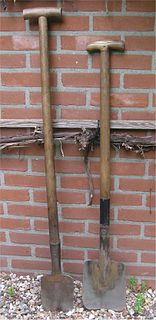 W
WA spade is a tool primarily for digging, comprising a blade – typically stunted and less curved than that of a shovel – and a long handle. Early spades were made of riven wood or of animal bones. After the art of metalworking was developed, spades were made with sharper tips of metal. Before the introduction of metal spades manual labor was less efficient at moving earth, with picks being required to break up the soil in addition to a spade for moving the dirt. With a metal tip, a spade can both break and move the earth in most situations, increasing efficiency.
 W
WA string trimmer, also called a "weed eater", "weed whacker", "weed whip", "line trimmer", "brush cutter", "whipper snipper" or "strimmer", is a gasoline, electric, or battery powered garden tool for cutting grass, small weeds, and groundcover. It uses a whirling monofilament line instead of a blade, which protrudes from a rotating spindle at the end of a long shaft topped by a motor.
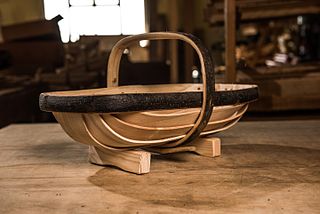 W
WA Sussex trug is a wooden basket. It is made from a handle and rim of coppiced sweet chestnut wood which is hand-cleft then shaved using a drawknife. The body of the trug is made of five or seven thin boards of white willow, also hand-shaved with a drawknife. They may have originated in Sussex because of the abundance of chestnut coppice and willows found on the marshes. Nails or pins used are usually copper, to avoid rust.
 W
WA tap is a valve controlling the release of a liquid or gas.
 W
WA trowel is a small hand tool used for digging, applying, smoothing, or moving small amounts of viscous or particulate material. Common varieties include the masonry trowel, garden trowel, and float trowel.
 W
WA watering can is a portable container, usually with a handle and a funnel, used to water plants by hand. It has been in use since at least 79 A.D. and has since seen many improvements in design. Apart from watering plants, it has varied uses, as it is a fairly versatile tool.
 W
WA number of common weeding tools are designed to ease the task of removing weeds from gardens and lawns.The fulcrum head weeder has a split tip like a serpent's tongue, and a long thin handle. Many models have a curved piece of metal along the handle which is put against the ground while the tip is digging. The curved metal piece acts as a fulcrum in a lever system. It is helpful to remove weeds either with a tap root or a fibrous root system. The Cape Cod weeder has a thin, long handle and a triangular scraping head. When the handle is held parallel to the ground, the head points downward. The crack weeder is a relative of the Cape Cod Weeder. It is designed to scrape out weeds growing in crevices, stone walls and other deep and narrow places. The plane of the L-shaped scraping blade includes the handle; the bottom of the "L" is parallel to it. Guna is a short traditional knife with a wide flat tip used for digging and weeding in the Philippines. Homi is a short-handled traditional weeding and ploughing tool used by Korean People.
 W
WA wheelbarrow is a small hand-propelled vehicle, usually with just one wheel, designed to be pushed and guided by a single person using two handles at the rear, or by a sail to push the ancient wheelbarrow by wind. The term "wheelbarrow" is made of two words: "wheel" and "barrow." "Barrow" is a derivation of the Old English "barew" which was a device used for carrying loads.
 W
WAn auger is a device to drill wood or other materials, consisting of a rotating metal shaft with a blade at the end that scrapes or cuts the wood.
 W
WA tree chipper or woodchipper is a machine used for reducing wood into smaller woodchips. They are often portable, being mounted on wheels on frames suitable for towing behind a truck or van. Power is generally provided by an internal combustion engine from 3 horsepower (2.2 kW) to 1,000 horsepower (750 kW). There are also high power chipper models mounted on trucks and powered by a separate engine. These models usually also have a hydraulic crane.